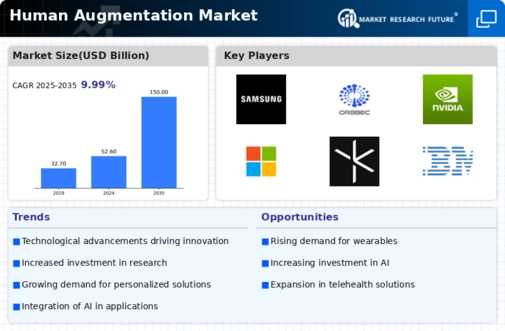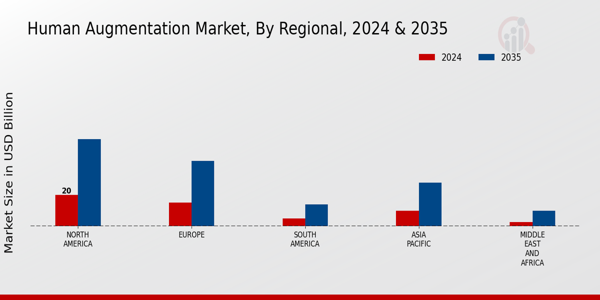Human Augmentation Size
Human Augmentation Market Growth Projections and Opportunities
In 2017, the Global Human Augmentation market was valued at USD 587.79 Million and is predicted to reach USD 2.84 Billion by 2023, showing a growth rate of 30.07% over the forecast period. The growth of the global human augmentation market can be attributed to several factors. One of the key contributors is the progress in modifying the human body. This involves using advanced technologies to enhance various aspects of human capabilities. Another factor driving market growth is the increasing awareness of exoskeletons for military applications. Additionally, there is a growing demand for wearable augmentation products.
However, the market faces challenges such as social and ethical concerns related to non-medical augmentation, as well as the high cost of medical implants and a shortage of skilled professionals, which are hindering its expansion on a global scale. The global Human Augmentation market, as analyzed by MRFR, is segmented based on product, end user, and region. In terms of products, the market is divided into wearable augmentation and in-built augmentation. Wearable augmentation, which includes devices you can wear, led the market by generating the highest revenue of USD 576.46 Million in 2017. It is expected to continue its dominance with a growth rate of 30.10% CAGR. On the other hand, in-built augmentation, which involves technologies integrated into the human body, is anticipated to be a growing market with a 28.78% CAGR.
This category includes brain computer interface (BCI), neurotechnology, and gene editing technology. Currently, these technologies are in the testing phase as they require a connection to the brain, which is still under research. However, it is expected that in-built augmentation will offer significant opportunities in the healthcare and defense sectors in the coming years. Regarding end-users, the healthcare sector is expected to witness high market growth in the coming years, with the highest CAGR of 30.54%. It is estimated to generate a high market value of USD 2.37 billion by 2023. The defense sector follows closely behind, projected to grow with a 28.92% CAGR. The defense industry is experiencing significant growth due to government investments in developing advanced exoskeletons and prosthetic arms technology.
The government's substantial investment in developing artificial intelligence (AI) technology is also contributing to the growth of technology in the defense sector in the coming years. In conclusion, the Global Human Augmentation market is experiencing substantial growth, driven by advancements in human body modification, increased awareness of exoskeletons for military applications, and a growing demand for wearable augmentation products. Despite facing challenges such as social and ethical concerns and the high cost of medical implants, the market is poised for expansion. The segmentation into wearable and in-built augmentation, as well as the focus on healthcare and defense end-users, highlights the diverse and promising opportunities in the field of human augmentation. The future holds exciting prospects as technology continues to advance and address the challenges faced by the market.

















Leave a Comment